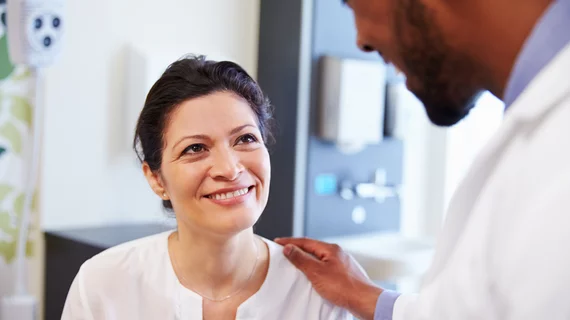5 ways radiologists can benefit from direct communication with patients
People often think of radiologists spending all day in their reading rooms, keeping to themselves as they interpret studies, but the specialty has worked hard in recent years to shatter that reputation. Increasing direct communication between radiologists and their patients is viewed as one big way radiology can reverse public perception and demonstrate its value to both patients and other healthcare providers.
A new analysis published in Current Problems in Diagnostic Radiology addressed the many ways radiologists can benefit from direct communication with patients. Prior studies had explored how patients would benefit from such communication, the authors noted, but they wanted to focus on the radiologists themselves.
1. It allows them to understand the impact of what they do
“Seeing patients in some capacity, whether it be in a formal consultation clinic, interdisciplinary conference, or via virtual consultation, allows radiologists to connect their work product to the patients and families they impact,” wrote authors Arvind Vijayasarathi, MD, MBA, MPH, department of radiology at the University of California Los Angeles David Geffen School of Medicine, and Richard Duszak Jr., MD, department of radiology and imaging sciences at Emory University School of Medicine in Atlanta. “Given the way many modern radiology practices are structured, the interpretation of examinations often takes place in settings remote in time and place from imaging acquisition. As such, the physical and psychological distance between patients and radiologists is quite far.”
The authors also explained that meeting with one patient may influence how a radiologist interprets future studies involving similar conditions or circumstances. This means that the specialist is demonstrating their value in the present while potentially improving their ability to help patients in the future.
2. It helps prevent burnout
Burnout continues to be an issue in radiology, and getting radiologists out of the reading room is one way leaders can work to keep burnout in their department to a minimum. Instead of working in silence around the clock and feeling underappreciated, radiologists get to spend time speaking with patients and feeling like they are truly part of a team.
3. It leads to better radiology reports
Thanks to healthcare’s push toward value-based care and the growth of patient portals, referring physicians are no longer the only people reading radiology reports. And by interacting with patients on a regular basis, radiologists can gain insight that will help them craft reports that are much more helpful.
“Direct consultation with patients provides a unique opportunity for radiologists to listen to the patients they serve,” the authors wrote. “By reviewing imaging findings with patients, answering questions, clarifying ambiguous statements or misconceptions, radiologists can gain relevant information from patient perspectives that can inform their practices moving forward.”
4. It improves follow-up adherence rates
According to Vijayasarathi and Duszak, asking radiologists to “convey the rationale and importance of appropriate imaging follow-up” could help get more patients to follow follow-up recommendations. This is typically the primary care physician’s responsibility, and they could still emphasize the importance of all recommendations, but it could be helpful for the patient to hear from the actual radiologist in these cases.
5. It emphasizes how vital radiologists are to healthcare as a whole
Direct communication with patients gives radiologists the perfect opportunity to demonstrate how much value they bring to the table. For example, patients might go from not even knowing what a radiologist does to going home and telling their loved ones about the kind radiologist they met during their doctor’s appointment.
“If patients and referring physicians become accustomed to affable and available onsite radiologists, who routinely communicate with them on an as needed basis, they may be less willing to accept alternative potentially lower cost corporate or teleradiology service providers,” the authors wrote. “This benefits all radiologists as it increases the ‘stickiness’ of the profession as groups across the country struggle with mounting pressures on many fronts.”

